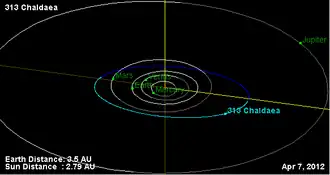313 Chaldaea
 Orbital diagram | |
| Discovery | |
|---|---|
| Discovered by | Johann Palisa |
| Discovery date | 30 August 1891 |
| Designations | |
| (313) Chaldaea | |
| Pronunciation | /kælˈdiːə/[1] |
Named after | Chaldea |
| Main belt | |
| Orbital characteristics[2] | |
| Epoch 31 July 2016 (JD 2457600.5) | |
| Uncertainty parameter 0 | |
| Observation arc | 122.79 yr (44849 d) |
| Aphelion | 2.8054 AU (419.68 Gm) |
| Perihelion | 1.9456 AU (291.06 Gm) |
| 2.3755 AU (355.37 Gm) | |
| Eccentricity | 0.18096 |
| 3.66 yr (1337.3 d) | |
| 262.291° | |
| 0° 16m 9.084s / day | |
| Inclination | 11.654° |
| 176.640° | |
| 316.013° | |
| Physical characteristics | |
| Dimensions | 96.34±1.7 km |
| 8.392 h (0.3497 d) | |
| 0.0524±0.002 | |
| C | |
| 8.90 | |
313 Chaldaea is a large Main belt asteroid. It is classified as a C-type asteroid and is probably composed of carbonaceous material.[2] It was discovered by Johann Palisa on 30 August 1891 in Vienna. It was named in honor of the Chaldeans, considered the founders of astrology.[3]
In 2003, the asteroid was detected by radar from the Arecibo Observatory at a distance of 1.07 AU. The resulting data yielded an effective diameter of 96 ± 14 km.[4]
References
- ^ Noah Webster (1884) A Practical Dictionary of the English Language
- ^ a b "313 Chaldaea". JPL Small-Body Database. NASA/Jet Propulsion Laboratory. Retrieved 11 May 2016.
- ^ Schmadel, L. (2003:42). Dictionary of minor planet names. Germany: Springer.
- ^ Magri, Christopher; et al. (January 2007), "A radar survey of main-belt asteroids: Arecibo observations of 55 objects during 1999 2003" (PDF), Icarus, 186 (1): 126–151, Bibcode:2007Icar..186..126M, doi:10.1016/j.icarus.2006.08.018, retrieved 14 April 2015.
External links
- 313 Chaldaea at AstDyS-2, Asteroids—Dynamic Site
- 313 Chaldaea at the JPL Small-Body Database